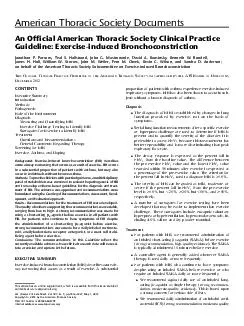

Parsons Teal S Hallstrand John G Mastronarde David A Kaminsky Kenneth W Rundell James H Hull William W Storms John M Weiler Fern M Cheek Kevin C Wilson and Sandra D Anderson on behalf of the American Thoracic Society Subcommittee on Exerciseinduced ID: 24924
Download Pdf The PPT/PDF document "American Thoracic Society Documents An O..." is the property of its rightful owner. Permission is granted to download and print the materials on this web site for personal, non-commercial use only, and to display it on your personal computer provided you do not modify the materials and that you retain all copyright notices contained in the materials. By downloading content from our website, you accept the terms of this agreement.
evidence).Itmaytake2Ð4weeksaftertheinitiationoftherapytoseemaximalimprovement.WerecommendagainstadministrationofICSonlybeforeexercise(strongrecommendationmoderate-qualityevidenceWerecommenddailyadministrationofaleukotrienereceptorantagonist(strongrecommendationmoderate-qualityevidenceWerecommendadministrationofamastcellstabilizingagentbeforeexercise(strongrecommendationhigh-qualityevidenceWesuggestadministrationofaninhaledanticholiner-gicagentbeforeexercise(weakrecommendationqualityevidenceInourclinicalpractices,wegenerallyaddadailyin-haledICSoradailyleukotrienereceptorantagonistÞrst,withthechoicebetweentheseagentsmadeonacase-by-casebasisdependinguponpatientpreferencesandbaselinelungfunction.Mastcellstabilizingagentsandinhaledanticholinergicagentsplayasecondaryrole.ForpatientswithEIBandallergieswhocontinuetohavesymptomsdespiteusinganinhaledSABAbeforeexercise,orwhorequireaninhaledSABAdailyormorefrequently,wesuggestadministrationofanantihistamine(weakrec-moderate-qualityevidence).Incontrast,weadministrationofantihistaminesinpatientswithEIBwhodonothaveallergies(strongrec-moderate-qualityevidenceForallpatientswithEIB,werecommendintervalorcom-binationwarm-upexercisebeforeplannedexercise(moderate-qualityevidenceForpatientswithEIBwhoexerciseincoldweather,wesuggestroutineuseofadevice(i.e.,mask)thatwarmsandhumidiÞestheairduringexercise(weakrecommendationlow-qualityevidenceForpatientswithEIBwhohaveaninterestindietarymodiÞcationtocontroltheirsymptoms:Wesuggestimplementationofalow-saltdiet(moderate-qualityevidenceWesuggestdietarysupplementationwithÞshoils(weakrecommendationlow-qualityevidenceWesuggestdietarysupplementationwithlyco-pene(weakrecommendationlow-qualityevidenceWesuggestdietarysupplementationwithascorbicacidweakrecommendationmoderate-qualityevidenceAnalgorithmsummarizingdiagnosisandtreatmentofEIBisprovidedinFigure1.Exercise-inducedbronchoconstriction(EIB)describesacuteairwaynarrowingthatoccursasaresultofexercise.TheexactprevalenceofEIBinpatientswithasthmaisnotknown,butex-erciseisonethemostcommontriggersofbronchoconstrictioninpatientswithasthma,andasubstantialproportionofpatientswithasthmaexperienceexercise-inducedrespiratorysymptoms.EIBhasalsobeenshowntooccurinsubjectswithoutaknowndiagnosisofasthma,withprevalenceofupto20%beingreported(1).Asaresult,thishasledtocontroversyregardingnomenclaturerelatedtobronchoconstrictionoccurringasaresultofexercise.ManyexpertsadvocateusingtheterminologyÒexercise-inducedbronchoconstrictionÓinsteadofÒexercise-inducedasthma,ÓasitdoesnotimplythatthepatienthasunderlyingchronicasthmaorthatexerciseactuallyÒcausedÓasthma.Forthepurposesofthisdocument,wewillusetheterminologyÒexercise-inducedbroncho-constrictionÓwithoutregardtowhetheritoccursinpatientswithorwithoutasthma.TherearesubstantialdatashowingthatEIBoccursverycom-monlyinathletesatalllevels.ManystudieshavebeenperformedinOlympicorelite-levelathletesthathavedocumentedpreva-lenceofEIBvaryingbetween30and70%,dependingonthepopulationstudiedandmethodsimplemented(1).Studieshavealsobeendoneoncollege,highschool,andrecreationalathletesthathaveshownasigniÞcantprevalenceofEIB(2Ð4).ThesymptomsofEIBarevariableandnonspeciÞc,andpres-enceorabsenceofspeciÞcrespiratorysymptomshasverypoorpredictivevalueforobjectivelyconÞrmedEIB(4,5).Clinicalpresentationmayincludechesttightness,cough,wheezing,anddyspnea.ThesesymptomsmayonlybeprovokedbyexerciseormayonlyoccurinspeciÞcenvironments,suchasicerinksorindoorswimmingpools.Thesymptomsareoftenmildtomoder-ateinseverityandmaycauseimpairmentofathleticperformance,butarenotsevereenoughtocausesigniÞcantrespiratorydistress.However,severeepisodesofEIBcanoccur,andrespiratoryfail-ureandevendeathhaveoccurredinrarecases(6).GiventhesigniÞcantprevalenceofEIB,itiscriticalthatevidence-baseddocumentsexisttoguidehealthcareproviderswithregardtothepathogenesis,diagnosis,management,andtreatmentofEIB,aswellasothercriticalissuesrelatedtoEIB,suchasen-vironmentalinßuencesandconsiderationsinOlympic/elite-levelathletes.Toprovidesuchguidance,amultidisciplinarypanelwasconvenedtodevelopevidence-basedguidelines.TheseguidelinesweredevelopedinaccordancewiththeAmericanTho-racicSocietyÕs(ATSÕs)standardsforclinicalpracticeguidelines(Table1).Themethodsaredescribedindetailintheonlinesupplement.Amodestperiodofhigh-intensityexerciseor,alternatively,in-creasedminuteventilationduringisocapnichyperpneatriggersaprototypicalresponseconsistingofbronchoconstriction,whichoccurspredominantlyafterthecessationofashortperiodof TABLE1.METHODSCHECKLISTYesNoPanelassemblyIncludedexpertsforrelevantclinicalandnonclinicalIncludedindividualwhorepresentstheviewsofpatientsandsocietyatlargeIncludedamethodologistwithappropriateexpertise(documentedexpertiseinconductingsystematicreviewstoidentifytheevidencebaseandthedevelopmentofevidence-basedrecommendations)LiteraturereviewPerformedincollaborationwithlibrarianXSearchedmultipleelectronicdatabasesXReviewedreferencelistsofretrievedarticlesXEvidencesynthesisAppliedprespeci edinclusionandexclusioncriteriaXEvaluatedincludedstudiesforsourcesofbiasXExplicitlysummarizedbene tsandharmsXUsedPRISMA1toreportsystematicreviewN/AUsedGRADEtodescribequalityofevidenceXGenerationofrecommendationsUsedGRADEtoratethestrengthofrecommendationsXAmericanThoracicSocietyDocuments hyperpneaandlastsfrom30to90minutesintheabsenceoftreat-ment.Thepredispositiontothedevelopmentofthissyndromevariesmarkedlyamongsubjectswithasthma,andisknowntooccurinsomegroupsofsubjectswithoutasthma,suchaseliteathletes.SeveralstudiesindicatethatsubjectswhoarepronetoEIBhaveincreasedlevelsofexhalednitricoxide(7),leuko-trienes(8,9),expressionofmastcellgenes(10),andepithelialsheddingintotheairwaylumen(9).Althoughtheeventsthattriggerthissyndromearenotfullyunderstood,itisclearthatinßammatorymediators,includinghis-tamine,tryptase,andleukotrienes,arereleasedintotheairwaysfromcellularsourcesintheairways,includingeosinophilsandmastcells(11,12).TheactivationofsensorynervesmayplayanimportantroleinthepathogenesisofEIB,andmaybein-volvedinmucusreleaseintotheairwaysafterexercisechallenge(13,14).Theepitheliummayplayakeyroleinsensingthetrans-ferofwaterandheatoutofthelowerairways,butthewayinwhichthisepithelialresponseleadstocellularactivationbyleu-kocytesremainsincompletelyunderstood.Eachisdescribedindetailintheonlinesupplement.ROLEOFTHEENVIRONMENTThehighprevalenceofEIBinpopulationsofathletesmayberelatedtospeciÞcenvironmentaldemandsofspeciÞcsports(15).Forexample:Theapproximate30%prevalenceofEIBreportedinicerinkathleteshasbeenlinkedtotheinhalationofcolddryairincombinationwiththehighemissionpollutantsfromfossil-fuelediceresurfacingmachines(16Ð18).Thehighprevalenceofairwayinjuryandbronchialhyper-responsivenessreportedamongNordicskiershasbeenattributedtohighventilationinhalationofcold,dryairduringtrainingandcompetition(19Ð21).The11Ð29%prevalenceofasthmaandEIBreportedamongcompetitiveswimmers(22)hasbeenassociatedwiththehighlevelsoftrichloraminesintheindoorpoolair(23Ð25).TheprevalenceofEIBamongdistancerun-nersishigherthanthatofthegeneralpopulation,andhasbeenattributedtoexercisinginhighallergen(26)andhighozoneenvironments(27).Amongtheenvironmentalexposuresthathavebeenpro-posedtocontributetoEIBarecoldair,dryair,ambientozone,andairborneparticulatematter.Susceptiblepopula-tions,suchaschildrenandthosewithpre-existingcardiovas-culardisease,diabetes,orlungdisease,aremoresensitivetoanacutelyincreasedfractionofparticlesdepositedinthelungsduringexercise.Evidencesupportsincreasedairwayhyperresponsivenessanddecreasedlungfunctionfromchronicexposuretoairpollutantsduringexercise.Theeffectsofeachexposureandtheevidenceforeacharedescribedindetailintheonlinesupplement.ThediagnosisofEIBisestablishedbychangesinlungfunctionafterexercise,notonthebasisofsymptoms.Symptomsthatareoftenassociatedwithvigorousexercise,suchasshortnessofbreath,cough,wheeze,andmucusproduction,areneithersen-sitivenorspeciÞcforidentifyingthosewithEIB(4,5,28).Amongathleteswithandwithoutsymptomsassociatedwithexercise,EIBcanbeidentiÞedinindividualswithoutsymptoms,andmanyindividualswithrespiratorysymptomswillnothaveEIB(4,5,28Ð31).MeasuringandQuantifyingEIBSeriallungfunctionmeasurementsafteraspeciÞcexerciseorhy-perpneachallengeareusedtodetermineifEIBispresentandtoquantifytheseverityofthedisorder.Itispreferabletoassess,asthismeasurementhasbetterrepeatability(32)andismorediscriminatingthanpeakexpiratoryßowrate(33Ð35).ThemeasurementofFEV(in3-to6-year-oldchildren)andair-wayresistanceusingtheinterrupttechnique(in5-to12-year-oldchildren)havebeenusedsuccessfullytoestablishadiagnosisofEIB(36,37).RecoveryfromEIBisusuallyspontaneous,andreturnsto95%baselinevaluewithin30Ð90minutes.Inagroupof7-to12-year-oldchildren,recoveryoccurredfasterintheyoungerchildren(38).AccordingtoATS/EuropeanRespiratorySocietyguidelines,atleasttworeproducibleFEVmaneuversaremeasuredseriallyafterexercisechallenge,withthehighestacceptablevaluerecordedateachinterval(39,40).FEVisusuallymeasuredat5,10,15,and30minutesafterexercise,butmaybemore Figure1Diagnosticandtreatmentalgorithmforexercise-inducedbronchoconstriction.EIBexercise-inducedbron-choconstriction;ICSinhaledcorticosteroid;LABAlong-acting-agonist;LTRAleukotrienereceptorantagonist;MCSAmastcellstabilizingagent;SABAshort-acting-agonist.*Orsurrogatechallenge,forexample,hyperpneaormannitol.1018AMERICANJOURNALOFRESPIRATORYANDCRITICALCAREMEDICINEVOL1872013 frequentifasevereresponseisexpected.AnFVCmaneuverisnotrequired,asrepeatedeffortsmaytirethesubject.Theair-wayresponseisexpressedasthepercentfallinFEVfromthebaselinevalue.Thedifferencebetweenthepre-exerciseFEVvalueandthelowestFEVvaluerecordedwithin30minutesafterexerciseisexpressedasapercentofthepre-exercisevalue(40).ThecriterionforthepercentfallinFEVusedtodiagnoseEIBis10%insomeguidelines(40Ð43).The10%fallvaluewasbasedonthemeanplustwoSDsofthepercentfallinFEVinnormalhealthysubjectswithoutafamilyhistoryofasthma,atopy,orrecentupperrespiratorytractinfection(35,44,45).HighervaluesforpercentfallinFEV(i.e.,15and13.2%)havebeenrecommendedfordiagnosingEIBinchildren(46Ð48).Afallof10%attwoconsecutivetimepointshasbeenrecom-mended(49).Manylaboratoriesuseacriterionof15%frombaselinebecauseofthegreaterspeciÞcityofthiscriterion.ThereproducibilityofEIBasdeterminedbytwoseparatetestsisgood,with76%agreementbetweentests.Theresponsein(percentdecline)is14.6%whenbothtestsdemonstrate10%fall,and15.7%whenonlyonetestdemonstrates10%fall.Thus,twotestsmayberequiredwhenusingexer-cisetoexcludeadiagnosisofEIB(44).TheseverityofEIBcanbegradedasmild,moderate,orsevereifthepercentfallinfrompre-exerciselevelis10%but25%but50%,and50%,respectively(50Ð52).ThisgradingwasbasedontherangeofmeasuredvaluesforEIBandbeforethewide-spreaduseofinhaledsteroids.Currently,adeclineinFEV30%inapersontakinginhaledsteroidswouldbeconsideredExerciseChallengeTestingtoIdentifyEIBThetype,duration,andintensityofexerciseandthetemperatureandwatercontentoftheairinspiredareimportantdeterminantsoftheairwayresponsetoexercise(53Ð60).Thetimesincethelastexerciseisalsoimportant,becausesomesubjectsbecomerefrac-torytoanotherexercisestimulusforupto4hours(61Ð63).ThetwomostimportantdeterminantsofEIBarethesustainedhigh-levelventilationreachedduringexerciseandthewatercontentoftheairinspired(54,55,64Ð67).Theventilationrequiredforavalidtestisatleast17.5timesFEVandpreferablygreaterthan21timesFEV(68).MeasurementofventilationduringtestingforEIBpermitscomparisonstobemadeontheeffectofthesamestimulusovertimeandbetweensubjects(68).Althoughheartrateisoftenusedasasurrogatemeasureoftheintensityofexercise,therelationshipbetweenheartrateandventilationvarieswidelybasedonÞtnessandotherfac-tors(69).TheidealprotocoltodetectEIBinvolvesarapidincreaseinexerciseintensityoverapproximately2Ð4minutestoachieveahighlevelofventilation.Mostprotocolsrecommendbreathingdryair(10mgHO/L)withanoseclipinplacewhilerunningorcyclingataloadsufÞcienttoraisetheheartrateto80Ð90%ofpredictedmaximum(predictedmaximumheartrateinyears)(44,47,48,69Ð71)orventilationtoreach17.5Ð21timesFEV(68,72,73).Oncethislevelofexerciseisattained,thesubjectshouldcontinueexerciseatthathighlevelforanaddi-tional4Ð6minutes.Thesetargetsaremorerapidlyachievedwithrunningexercisecomparedwithcycling.Sports-speciÞcexerciseisprobablythemostrelevantforeliteathletesthatcanbetestedduringtheactivitythatcausessymptoms(28).Theuseofshort-actingandlong-termpreventativeasthmamedications(68,72,73),recentintenseorintermittentwarm-upexercise(61Ð63),recentuseofnonsteroidalanti-inßammatorymedication(74),andrecentexposuretoinhaledallergensmayaltertheseverityoftheresponsetoexercisechallenge(75Ð77).SurrogatesforExercisetoIdentifyEIBAnumberofsurrogatesforexercisetestinghavebeendevelopedthatmaybeeasiertoimplementthandryairexercisechallenge.Thesesurrogatesincludeeucapnicvoluntaryhyperpneaofdryairandinhalationofhyperosmolaraerosolsof4.5%salineordrypowdermannitol.AlthoughnoneofthesesurrogatetestsarecompletelysensitiveorspeciÞcforEIB,theyallhaveutilityforidentifyingairwayhyperresponsivenessconsistentwithadi-agnosisofEIB(4,78Ð88).Thesurrogatesofexercisearede-scribedindetailintheonlinesupplement.TreatmentforEIBcanbebrokendownintopharmacologicandnonpharmacologictherapy.Currentlyusedpharmacologicther-apyincludesshort-acting-agonists(SABAs)andlong-acting-agonists(LABAs),leukotrienereceptorantagonists(LTRAs),andinhaledcorticosteroids(ICSs).Mastcellstabilizingagents(MCSAs)havetraditionallybeenusedtotreatEIB,and,althoughtheseagentsarenolongeravailableintheUnitedStates,theyremainavailableinothercountriesaroundtheworld.Otherdrugs,suchasinhaledanticholinergicagents(ipratropium)andantihistamines,mayplayaminorroleintreatingsomepatientswithEIB.Nonpharmacologictherapyincludeswarm-uptoinducearefractoryperiod,maneuverstoprewarmandhumidifytheairduringexercise(e.g.,breathingthroughafacemaskorscarf),improvinggeneralphysicalconditioning,losingweightifobese(89),andmodifyingdietaryintake.ThegoalsoftherapyaretorelievebronchoconstrictionshoulditoccurandtominimizeorpreventbronchoconstrictionfromhappeningintheÞrstplace,thusallowingtheathleteorpatientwithEIBtocontinuetoengageinphysicalactivityorsportswithminimalrespiratorysymptoms.QuestionsandRecommendationsQuestion1:ShouldpatientswithEIBbetreatedwithaninhaledSABAbeforeexercise?ThemostcommontherapeuticrecommendationtominimizeorpreventsymptomsofEIBistheprophylacticuseofshort-actingbronchodilators(-agonists),suchasalbuterol,shortlybeforeexercise(90).Theseagentsworkbystimulatingreceptorsonairwaysmoothmuscle,causingmusclerelaxationandbronchodilation,aswellaspossiblypreventingmastcelldegranulation.SABAs,givenbyinhalation5Ð20minutesbeforeexercise,areusuallyeffectivefor2Ð4hoursinprotectingagainstorattenuatingEIB(91,92),butmayfailtopreventbroncho-constrictionin15Ð20%ofpatientswithasthma(72).Inaddition,dailyuseof-agonistsaloneorincombinationwithICSsmayleadtotolerance,manifestedasareductionindurationofpro-tectionagainstEIB,andaprolongationofrecoveryinresponsetoSABAafterexercise(93,94).Toleranceisthoughttobeduetodesensitizationofthe-receptorsonmastcellsandairwaysmoothmuscle.Thisiswhy-agonistsaregenerallyonlyusedonanintermittentbasisforpreventionofEIB,andwhypatientswhouseSABAsonamoreregularbasis(e.g.,daily)aregen-erallystartedonacontrolleragent,suchasICSorLTRAs.OurrecommendationforaninhaledSABAbeforeexerciseisbaseduponasystematicreviewoftheliteraturethatidentiÞedeightrandomizedtrials,ofwhichÞvewerepooled.PatientswhoreceivedaninhaledSABAhadamaximumpercentfallinFEVafterexercisethatwas26.03%lessthanthatamongpatientswhoreceivedplacebo.Thelargemagnitudeofeffectwasnotoffsetbyriskofbias,indirectness,inconsistency,orimprecision.Thus,theevidenceprovidedhighconÞdenceintheestimatedeffectsofinhaledSABA.Therecommendationisstrong,AmericanThoracicSocietyDocuments becausethecommitteeiscertainthatthereductionofbreath-lessnessassociatedwiththelowermaximumpercentfallinafterexerciseoutweighstherelativelyminorpotentialsideeffects,burdens,andcostofpre-exerciseSABAtherapyTableE1inARecommendation1:ForpatientswithEIB,werecommendadministrationofaninhaledSABAbeforeexercisestrongrec-ommendation,high-qualityevidenceTheinhaledSABAistyp-icallyadministered15minutesbeforeexercise.Suchuseshouldbelessthandaily,onaverage.Question2:ShouldpatientswithEIBbetreatedwithanin-haledLABA?AcontrolleragentistypicallyaddedwheneverSABAther-apyisusedonadailybasisormorefrequently.LABAsareef-fectiveintreatingandpreventingEIB(72,95);however,similartotheuseofSABAs,theprotectiveeffectaffordedbyLABAsdecreaseswithdailyuse(96Ð98).AlthoughLABAsmayini-tiallyprotectagainstbronchoconstrictionfor6Ð12hours,theeffectdiminishestolastingonly6hoursafterdailyusefor30days(97).Unfortunately,concomitantuseofdailyICSdoesnotmitigatethislossofeffectiveness(96,98).Onestudyfoundthatformoterolremainedeffectiveaslongasitwasusedthreetimesperweekorless;so,asasingleagent,LABAsmaybeusedforEIBatthisfrequency(99).However,thereremainsseriousconcernaboutincreasedmorbidityandmortalitywithanyuseofLABAsasmonotherapy,withoutconcomitantICSinpatientswithasthma(100,101).OurrecommendationagainstdailyLABAmonotherapyisbaseduponourreviewoftheliterature,whichidentiÞedtworel-evantrandomizedtrials(102,103).BothtrialscomparedLABAmonotherapytoplaceboafterthewithdrawalofICSsandfoundanincreasedrateoftreatmentfailuresandacuteexacerbationsamongthosereceivingLABAmonotherapy.Otherrandomizedtrialsandmeta-analysesthatevaluatedLABAtherapywerealsoidentiÞed;however,mostincludedpatientswhowerereceivingconcomitantICSs.ThestudiesthateitherincludedalargeproportionofpatientsreceivingLABAasmonotherapyoranalyzedpatientswhowerereceivingLABAmonotherapyseparatelysupportedthepotentialforincreasedadverseeffectsamongthosereceivingLABAmonotherapy(100,101).ThisevidenceprovidesmoderateconÞdenceintheestimatedeffectsofLABAmonotherapy,becausetherandomizedtrialshadindirectness(i.e.,thetrialsincludedpatientswithasthmaingeneral,notpatientswithEIBspeciÞcally).TherecommendationagainstdailyLABAtherapyisstrong,becausetheimportanceofthepotentialdownsidesofLABAmonotherapy(i.e.,seriousad-verseeffects,includingasthma-relatedmortality,exacerbationsre-quiringhospitalization,cost,andburdens)substantiallyoutweightheupsides(i.e.,lessdyspnea,lessneedforinhaledSABAs),par-ticularlyinlightoftheavailabilityofsaferalternativetherapies.Recommendation2:ForpatientswithEIBwhocontinuetohavesymptomsdespiteusinganinhaledSABAbeforeexercise,orwhorequireaninhaledSABAdailyormorefrequently,wedailyuseofaninhaledLABAassingle(strongrecommendation,moderate-qualityevidence).Question3:ShouldpatientswithEIBbetreatedwithICSs?DailyICSsareconsideredthemosteffectiveanti-inßammatoryagentsforEIB(104).Thismaybeduenotonlytobettercontrolofunderlyingasthma,butperhapstoadirecttherapeuticeffectonairwayinßammationthatisassociatedwithEIB(11,105,106).ICScanbeusedaloneorincombinationwithothertreatmentsforEIB.Asmentionedpreviouslyhere,ICStherapydoesnotpreventtheoccurrenceoftolerancefromdaily-agonistuse.Studiesoninhaledsteroidshaveshownthatthemaximumben-eÞcialeffectinprotectingagainstEIBmaytakeaslongas4weeks,andisdosedependent(104,107).Althoughasinglehighdoseofbeclomethasonedipropionatehasbeenshowntohaveaprotectiveeffectagainsthyperpnea-inducedbronchospasm,thisstrategyisnotrecommendedclinically(108).Interestingly,ICSdonotseemtobeasprotectiveineliteathleteswithoutasthmawhoexperienceEIBcomparedwithpatientswithasthmawithEIB(109).Aswithallinhaledmedications,properinhalertech-niquemustbetaughttothepatientandreinforcedatfollow-upvisits.OurrecommendationforaICSisbaseduponasystem-aticreviewthatfoundsixrandomizedtrials,ofwhichfourwerepooled.PatientswithEIBwhoreceivedadailyICShadameanmaximumpercentfallinFEVafterexercisethatwas10.98%lessthanthatseenamongpatientswhoreceivedplacebo.Therandomizedtrialswerelimitedbyimprecision(i.e.,theendsoftheconÞdenceintervalsledtodifferentclinicaldecisions),pro-vidingmoderateconÞdenceintheestimatedeffects.Therec-ommendationisstrongbecausethecommitteeiscertainthatthereductionofdyspneaassociatedwiththedecreaseinthemaximumpercentfallinFEVafterexerciseoutweighsthere-lativelyminorburdens,cost,andsideeffectsofICStherapy(TableE2AinAOurrecommendationagainstICSisbaseduponasystematicreviewthatidentiÞedfourrandomizedtrials,ofwhichtwowerepooled.PatientswithEIBwhoreceivedpre-exerciseICShadameanmaximumpercentfallinFEVexercisethatwassimilartothatseenamongpatientswhore-ceivedplacebo.Therandomizedtrialswerelimitedbyimpreci-sion,providingmoderateconÞdenceintheestimatedeffects.Therecommendationisstrongbecausethecommitteeiscertainthatthedownsidesofpre-exerciseICSexceedtheupsides.ThereappeartobenosigniÞcantbeneÞts,buttherearepotentialsideeffects,costs,andburdens(seeTableE2BinAPPENDIX2).Recommendation3A:ForpatientswithEIBwhocontinuetohavesymptomsdespiteusinganinhaledSABAbeforeexercise,orwhorequireaninhaledSABAdailyormorefrequently,werecommenddailyadministrationofanICS(strongrecommen-dation,moderate-qualityevidence).Itmaytake24weeksaftertheinitiationoftherapytoseemaximalimprovement.Recommendation3B:Forthesamepatients,werecommendadministrationofICSonlybeforeexercise(strongrec-ommendation,moderate-qualityevidence).Question4:ShouldpatientswithEIBbetreatedwithLTRAs?LTRAs,suchasmontelukast,givenoncedaily,willreduceEIBandalsoimprovetherecoverytobaseline.Thereisnode-velopmentoftolerancewhentakendaily(110).ThemagnitudeofeffectmaybesmallerforLTRAsthaneitherICSorpre-exerciseSABA.However,thedurationofactionislonger,last-ingupto24hours,whichmaybeveryusefulforpatientsorathletesengaginginphysicalactivitythroughouttheday(111,112).LTRAsshouldbetakenatleast2hoursbeforeexercisetohaveamaximalprophylacticeffect(111).LTRAsappeartoprotectagainstEIBregardlessofwhetherpatientshaveasthmaorareeliteathleteswithoutasthma(113).OurrecommendationforadailyLTRAisbaseduponasys-tematicreviewthatidentiÞed11randomizedtrials,ofwhich7werepooled.PatientswithEIBwhoreceivedadailyLTRAhadameanmaximumpercentfallinFEVafterexercisethatwas10.70%lessthanthatseenamongpatientswhoreceivedplacebo.Therandomizedtrialswerelimitedbyimprecision,providingmoderateconÞdenceintheestimatedeffects.Therecommendationisstrongbecausethecommitteeiscertainthatthereductionofdyspneaassociatedwiththedecreaseinthe1020AMERICANJOURNALOFRESPIRATORYANDCRITICALCAREMEDICINEVOL1872013 maximumpercentfallinFEVafterexerciseoutweighsthecomparativelyminorburdens,cost,andsideeffectsofLTRAtherapy(TableE3inAThechoiceofwhethertoadddailyICSordailyLTRAtoas-neededuseofSABAinpatientswithEIBwhodonotrespondtointermittentSABAtherapyalone,inmostcases,isapersonalonethatshouldbemadeonacase-by-casebasis.Strictlyspeak-ing,theevidencesupportsefÞcacyofbothtypesofmedicationsinEIB,althoughICStherapymayhaveamorepotentanti-inßammatoryeffectinpatientswithEIBassociatedwithairwayinßammation.ThismayberelevanttothepatientwithasthmawithEIBasopposedtotheeliteathletewithoutasthmawithEIB,inwhomICSmayworkbetterintheformer.Incaseswherebaselinelungfunctionisbelownormal,guidelinesrecommenduseofICSinitially(90).BothclassesofmedicinesarereadilyavailableintheUnitedStatesincontrasttoMCSAs.SomepatientswouldprefertoavoidusinganinhalerandavoidusingdailyICS;inthesesituations,tryingadailyLTRAwouldbereasonable,or,ifnotexercisingdaily,thenusingmontelukastatleast2hoursbeforeplannedexercise.OtherpatientsmayprefertouseinhaledICSbecausetheywanttoavoidanypotentialsystemiceffectsofdailyLTRAtherapy;inthesecases,tryingdailyICSwouldbereasonable.Inallcases,itisalwayses-sentialtoensurethatunderlyingasthmaisundercontrol,andcontinuedandclosefollowupwiththepatientisimportanttoachievetherapeuticeffectonminimalandacceptablemedication.Recommendation4:ForpatientswithEIBwhocontinuetohavesymptomsdespiteusinganinhaledSABAbeforeexercise,orwhorequireaninhaledSABAdailyormorefrequently,werecommenddailyadministrationofanLTRA(strongrecom-mendation,moderate-qualityevidence).Question5:ShouldpatientswithEIBbetreatedwithanMCSA?MCSAs,suchassodiumcromoglycateandnedocromilso-dium,provideprotectionagainstEIBbyblockingdegranulationofmastcellsandreleaseofmediators,suchasprostaglandinDCochraneReviews(114,115)havedemonstratedconsistentprotectionagainstEIB,withanattenuationofEIBbyabout50%.TherearenosigniÞcantdifferencesbetweensodiumcro-moglycateandnedocromilsodium.MCSAsappeartobemoreeffectiveatattenuatingEIBthananticholinergicagents,butlesseffectivethanSABAs.Thereappearstobenoadvantagetocom-biningMCSAswithSABAs,astheeffectsaresimilartousingSABAsalone.OurrecommendationforanMCSAbeforeexerciseisbaseduponasystematicreviewthatidentiÞed24randomizedtrials,ofwhich20werepooled.PatientswithEIBwhoreceivedanMCSAbeforeexercisehadameanmaximumpercentfallinFEVexercisethatwas15.20%lessthanthatseenamongpatientswhoreceivedplacebo.Therandomizedtrialshadnoseriousriskofbias,indirectness,inconsistency,orimprecision,therebyprovidingahighdegreeofconÞdenceintheestimatedeffects.TherecommendationisstrongbecausethecommitteeiscertainthatthereductionofdyspneaassociatedwiththedecreaseinthemaximumpercentfallinFEVafterexerciseoutweighsthecomparativelyminorburdens,cost,andsideeffectsofpre-exerciseMCSAtherapy(TableE4inAAlthoughtheevidenceforMCSAsishighquality,itisimpor-tanttonotethatthelackofavailabilityofthesemedicationsintheUnitedStatesmaymakethisrecommendationlessclinicallyapplicableintheUnitedStates,althoughtheyarereadilyavail-ableworldwide.Recommendation5:ForpatientswithEIBwhocontinuetohavesymptomsdespiteusinganinhaledSABAbeforeexercise,orwhorequireaninhaledSABAdailyormorefrequently,werecommendadministrationofanMCSAbeforeexerciserecommendation,high-qualityevidence).Question6:ShouldpatientswithEIBbetreatedwithanan-AntihistamineshavebeenstudiedasatreatmentforEIB.Theresultsofthesestudiesarevariable,withsomeprotectionagainstEIBseeninasmallpercentageofpatients(116,117).Thein-consistencyinthedatamaybeduetodifferencesintheseverityofEIBstudiedandtheabilityofterfenadine,usedinsomeofthepositivestudies,toalsoinhibitleukotrienes,thusconfound-ingthespeciÞcroleofanantihistamineeffect(118).Becausecontrollingallergiesinpatientswithatopywithasthmaleadstobetterasthmacontrolingeneral,itseemsprudentthatallergicpatientswithasthmawithEIBmaybeneÞtfromantihistaminetherapy(119).AsystematicreviewoftheevidenceidentiÞedthreerandom-izedtrials,whichwerepooled.PatientswithEIBwhoreceivedadailyantihistaminehadnosigniÞcantdecreaseintheirmeanmaximumpercentfallinFEVafterexercisecomparedwithpatientswhoreceivedplacebo.Therandomizedtrialswerelim-itedbyimprecision,providingmoderateconÞdenceintheÞnd-ingofnoeffect(TableE5inAOurrecommendationfordailyantihistaminetherapyinaller-gicpatientsindicatesthecommitteeÕsbeliefthatantihistaminesmaybehelpfulinEIB,ascontrollingallergiesimprovesasthmacontrolingeneral.TheweakstrengthoftherecommendationreßectstheuncertaintyaboutthebalanceofpotentialbeneÞtsversusharms,burdens,andcost,astherelevanttrialsdidnotanalyzeindividualswithatopyseparately.Incontrast,ourrecommendationagainstantihistaminesinnonallergicindividualsisstrongbecausethecommitteeiscertainthatthedownsidesexceedtheupsides.AntihistaminesappeartoconfernosigniÞcantbeneÞtsinsuchpatients,buthavepotentialsideeffects,costs,andburdens.Recommendation6A:ForpatientswithEIBandallergieswhocontinuetohavesymptomsdespiteusinganinhaledSABAbeforeexercise,orwhorequireaninhaledSABAdailyormorefrequently,wesuggestusinganantihistaminetopreventEIB(weakrecommendation,moderate-qualityevidence).Recommendation6B:FornonallergicpatientswithEIBwhocontinuetohavesymptomsdespiteusinganinhaledSABAbe-foreexercise,orwhorequireaninhaledSABAdailyormorefrequently,werecommendagainstusingantihistamines(strongrecommendation,moderate-qualityevidence).Question7:ShouldpatientswithEIBbetreatedwithashort-actinginhaledanticholinergic?Likeantihistamines,anticholinergictreatmentwithipratropiumhasvariableeffectsonpreventingortreatingEIB.Ourrecommen-dationforadministrationofaninhaledshort-actinganticholinergicagentbeforeexerciseisbaseduponapublishedsystematicreviewof12randomizedtrials,allofwhichwerepooled(115).PatientswithEIBwhoreceivedinhaledipratropiumbromidebeforeex-ercisehadameanmaximumpercentfallinFEVafterexercisethatwas9.80%lessthanthatseenamongpatientswhoreceivedplacebo.Theevidencewaslimitedbyinconsistentresultsandimprecision,providinglowconÞdenceintheestimatedeffects.TherecommendationisweakbecausethecommitteeisuncertainthatthereductionofdyspneaassociatedwiththedecreaseinthemaximumpercentfallinFEVafterexerciseoutweighsthepotentialsideeffects,burdens,andcost.Theuncertaintyderivesfromthesmalleffectsizeandthelowqualityofevi-dence(TableE6inAPPENDIXRecommendation7:ForpatientswithEIBwhocontinuetohavesymptomsdespiteusinganinhaledSABAbeforeexercise,AmericanThoracicSocietyDocuments orwhorequireaninhaledSABAdailyormorefrequently,wesuggestadministrationofaninhaledanticholinergicagentbefore(weakrecommendation,low-qualityevidence).Question8:ShouldpatientswithEIBengageinaphysicalactivitybeforeexercise,toinducearefractoryperiod?AnimportantnonpharmacologicstrategytominimizeEIBusedbymanyathletesistoengageinphysicalwarm-upbeforetheplannedperiodofexerciseorcompetition(62,63,120,121).Typically,thewarm-upconsistsof10Ð15minutesofmoderatelyvigorousexercise,andsubsequentEIBisreducedforthenext2hours,resultinginaso-calledÒrefractoryperiod.ÓThisphe-nomenondoesnotoccurinallathletes,andmaynotoccuratallinathleteswithoutasthmawithEIB.Variousapproaches,in-cludinglow-intensity,high-intensity,interval,orcontinuousex-ercise,andcombinationsofthese,havebeentried(93).Arecentreviewofthissubjectsuggeststhatawarm-upconsistingofvariablehigh-intensityexercise,asopposedtocontinuoushigh-orlow-intensityexercise,appearstobethemosteffectivestrategytoattenuateEIB(122).Ourrecommendationforintervalorcombinationwarm-upexercisebeforeplannedexerciseisbaseduponapublishedsys-tematicreviewoffourrandomizedtrialsofintervalwarm-up,threerandomizedtrialsoflow-intensitycontinuouswarm-up,tworandomizedtrialsofhigh-intensitycontinuouswarm-up,andtworandomizedtrialsofcombinationwarm-up(115).PatientswithEIBwhounderwentinterval,low-intensitycon-tinuous,high-intensitycontinuous,orcombinationwarm-upbe-foreexercisehadameanmaximumpercentfallinFEVexercisethatwas10.61,12.60,7.97%,and10.94%lessthanthatseenamongpatientswhodidnotundergoformalwarm-up,respectively.TheseimprovementswerestatisticallysigniÞcantonlyforintervalandcombinationwarm-up.Theevidenceforintervalandcombinationwarm-upwaslim-itedbyimprecision,providingmoderateconÞdenceintheesti-matedeffects.Incontrast,theevidenceforlow-intensityandhigh-intensitycontinuouswarm-upwaslimitedbyinconsistentresultsandimprecision,providinglowconÞdenceintheesti-matedeffects(TablesE7AÐE7DinA2).Therec-ommendationisstrong,becausethecommitteeiscertainthatthereductionofdyspneaassociatedwiththedecreaseinthemaximumpercentfallinFEVafterintervalandcombinationwarm-upexerciseandtheeffectsofwarm-uponinjurypreven-tionoutweightheburdenandrisksofthewarm-upexercise.GeneralphysicalconditioningmayalsohelpattenuateEIB(89).Thislikelyoccursnotonthebasisofanydirecteffectonlungfunction,but,rather,indirectlyduetothelowerminuteventilationrequiredforanygivenworkloadoncecardiovascularconditioninghasbeenimproved.Recommendation8:ForallpatientswithEIB,werecom-mendintervalorcombinationwarm-upexercisebeforeplanned(strongrecommendation,moderate-qualityevidence).Question9:ShouldpatientswithEIBuseadevicetowarmorhumidifytheairwhentheyexerciseincoldweather?AnothertechniquetominimizeEIBsymptomsistoprewarmandhumidifytheinhaledair.Thisstrategyfollowsfromthecon-ceptthatbronchoconstrictioninEIBoccursasaresultofthecoolinganddryingoftheairwaysduringthehighminuteventi-lationofexercise.Twostrategiesthathavebeenemployedarebreathingthroughthenose(123)anduseofafacemask(124).Inonestudy,breathingthroughaheatexchangermaskwasaseffectiveasalbuterolinpreventingEIB(125).Ourrecommendationtouseadevicethatwarmsandhumidi-Þesairduringexerciseincoldweatherisbaseduponasystematicreviewthatfoundarandomizedtrialandtwononrandomizedcontrolledtrials.Intherandomizedtrial,patientswithEIBwhousedadevicetowarmandhumidifyairhadameanmax-imumpercentfallinFEVafterexercisethatwas14.70%lessthanthatseenamongpatientswhodidnotusesuchadevice.Thetrialwaslimitedbyriskforbiasandimprecision,providinglowconÞdenceintheestimatedeffects.Theresultoftheran-domizedtrialwasconsistentwithbothnonrandomizedcon-trolledtrials.TheweakstrengthoftherecommendationreßectsuncertaintyaboutthedegreeofbeneÞtÑuncertaintythatderivesfromthelowqualityofevidence(TableE8inRecommendation9:ForpatientswithEIBwhoexerciseincoldweather,wesuggesttheroutineuseofadevice(i.e.,mask)thatwarmsandhumidi estheairduringexercise(weakrecom-mendation,low-qualityevidence).Question10:ShouldpatientswithEIBchangetheirdietaryhabits(e.g.,low-saltdiet, shoilsupplementation,lycopene,vi-taminC)?Therehavebeenmanystudiesexaminingtheeffectsofdie-tarymodiÞcationonEIB(126Ð134).Low-sodiumdiet(130),Þshoil(omega-3polyunsaturatedfattyacids)supplementation(131),orallycopene(132),andascorbicacidsupplementation(1,500mg/day)(129)haveallbeenstudiedinrelationtoEIB.AllwerefoundtohavesomeeffectinreducingtheseverityofEIB,butallofthesestudieshadimportantlimitations,sotheirÞndingsshouldbeconsideredpreliminaryuntilconÞrmedinlargertrials.WithregardtoÞshoil,theremaybeadifferentialeffectoftreatmentdependingonwhetherthepatienthasun-derlyingasthma(inwhichcase,theÞshoilsupplementationmaynotattenuateEIB)(133)ornot(inwhichcase,ÞshoilsupplementationmayattenuateEIB)(134,135).Giventhelackofobviousrisktopatientsinadministeringtheseadjunctivetherapies,itisreasonabletotrythemininterestedpatients,buttheevidenceisnotstrongenoughtoconcludethattheyareeffectiveinalargemajorityofpatientswithEIB.Ourrecommendationforalow-saltdietisbaseduponasys-tematicreviewthatidentiÞedsixrandomizedtrials,whichcouldnotbepooledduetoinsufÞcientreportingofthecrudedata.Inallofthetrials,however,patientswithEIBwhoreceivedalow-saltdiethadasigniÞcantlysmallerdecreaseinthemeanmaxi-mumpercentfallinFEVafterexercisethanpatientswhodidnotreceivealow-saltdiet.Thesetrialsprovidedmoderatecon-Þdenceintheestimatedeffect,becausetheywerelimitedbyimprecision(TableE9AinAOurrecommendationforÞshoilsupplementationisbaseduponasystematicreviewthatidentiÞedonerelevantrandomizedtrialinwhichpatientswithEIBwhoreceivedÞshoilsupplementationhadameanmaximumpercentfallinFEVafterexercisethatwas11.50%lessthanthatseenamongpatientswhodidnotreceiveÞshoilsupplementation.TheevidenceprovidedlowconÞdenceintheestimatedeffectbecauseitwaslimitedbyimprecisionandinconsistency(asubsequenttrialthatmeasureddifferentout-comesfoundnoeffect).SeeTableE9BinAPPENDIXOurrecommendationagainstlycopenesupplementationisbaseduponasystematicreviewthatidentiÞedtworelevantran-domizedtrials.Inonetrial,patientswithEIBwhoreceivedly-copenehadameanmaximumpercentfallinFEVafterexercisethatwas11.80%lessthanthatseenamongpatientswhodidnotreceivelycopene.Incontrast,theothertrialfoundnoeffectfromlycopenesupplementation.TheevidenceprovidedlowconÞdenceintheestimatedeffectbecauseoftheinconsistencyoftheresultsandimprecision(TableE9CinAOurrecommendationforascorbicacid(i.e.,vitaminC)sup-plementationisbaseduponasystematicreviewthatidentiÞedtworelevantrandomizedtrials.Inbothtrials,patientswith1022AMERICANJOURNALOFRESPIRATORYANDCRITICALCAREMEDICINEVOL1872013 EIBwhoreceivedascorbicacidsupplementationhadameanmaximumpercentfallinFEVafterexercisethatwasapprox-imatelyhalfofthatseenamongpatientswhodidnotreceiveascorbicacidsupplementation.Theevidenceprovidedmoder-ateconÞdenceintheestimatedeffectbecauseitwaslimitedbyimprecision(TableE9DinAAlloftherecommendationsareweakbecausethecommitteeisuncertainthatthereductionofdyspneaassociatedwithdietarysupplementationoutweighstheburdenofdietarymodiÞcation.ThisuncertaintyderivesfromthelimitationsofthesupportiveRecommendation10A:ForpatientswithEIBwhohaveaninterestindietarymodi cationtocontroltheirsymptoms,wesuggestalow-saltdiet(weakrecommendation,moderate-qualityevidence).Recommendation10B:ForpatientswithEIBwhohaveaninterestindietarymodi cationtocontroltheirsymptoms,wesuggestdietarysupplementationwith shoils(weakrecommen-dation,low-qualityevidence).Recommendation10C:ForpatientswithEIBwhohaveaninterestindietarymodi cationtocontroltheirsymptoms,wedietarysupplementationwithlycopenerecommendation,low-qualityevidence).Recommendation10D:ForpatientswithEIBwhohaveaninterestindietarymodi cationtocontroltheirsymptoms,wesuggestdietarysupplementationwithascorbicacid(weakrecom-mendation,moderate-qualityevidence).GeneralCommentsRegardingTherapyOuroverallrecommendationsregardingtherapyleavealotofoptionsfortheindividualpatient,whichshouldbediscussedwiththepatientÕsphysicianandtriedandevaluatedonanongoingbasis.Themainstayoftherapyremainsmaintaininggoodcon-trolofunderlyingasthma(ifpresent)andpreventingortreatingsymptomsofEIBwithSABAs.Ifsuchtherapydoesnotwork,thenthenextbestoptionsaretoadddailyICSordailyLTRA,dependingonpatientpreference.Afterthis,thepatientmaytryaddingorsubstitutingwithinhaledmastcellstabilizing,anti-cholinergic,ororalantihistaminetherapy.Pre-exercisewarm-upisrecommendedforallpatients,asiswearingamaskorscarfincoldweatherforthosewithcoldweatherÐinducedsymptoms.ImprovingphysicalÞtnessandlosingweightifobeseseempru-dent.Finally,althoughthereisnotalotofevidencetosupportdietarymodiÞcation,patientswithaninterestinthisapproachmaytryalow-saltdiet,orsupplementingwithÞshoilorvitaminC.Theadditionoflycopeneisnotstronglysupported.SCREENINGFOREIBScreeningisdeÞnedasthestrategyusedinapopulationtodetectaconditioninapreclinicalorasymptomaticphasewiththeaimofprovidingtimelyinterventiontofavorablyinßuenceoutcome.Incontrast,casedetectionistheidentiÞcationofindividualswithdiseasewhoaresymptomatic,butundiagnosed.Anumberoforganizationsandinvestigatorsadvocatescreeningforasthmainboththegeneralpopulation(136)andinathletes(137Ð139),yetevaluationofscreeningbasedupontheWorldHealthOrganizationcriteria(describedintheonlinesupplement)revealsimportantdeÞcienciesinthedatarequiredtoensurethevalidityofthisapproach(140,141).Accordingly,anATSreportonscreeningforasthmathatwaspublishedin2007concludedthattherewasinsufÞcientevidencetosupporttheadoptionofpopulation-basedasthmacasedetection,basedprimarilyuponalackofdetailregard-inghealthoutcome(142).Itwas,however,feltthatcasedetectionprogramsmaybeappropriateinareaswherethereisahighprevalenceofundiagnosedasthma,andwherenewlydetectedcaseshaveaccesstohigh-qualitycare.Thisrecommendationispertinenttotheathleticpopulation,and,indeed,somesportingorganizationshaveestablishedEIBscreeningprogramsfortheirinternationallycompetitiveathletes(137,143).Yet,todate,expertworkinggroupshavenotdirectlyaddressedEIBscreeningpolicy(1,41,144).Wewereunabletolocateanyrandomizedcontrolledtrialsorlarge,welldoneobservationalstudies(i.e.,casecontrol,cohortstudies)evaluatingtheoverallefÞcacyofascreeningprogramforEIBoneitherhealthorperformanceoutcome.SuchstudiesaredifÞculttoconduct(145),but,nevertheless,theyremainapre-requisiteforarigorousevaluationofascreeningpolicy.There-fore,therepresentlyremainsmajoruncertaintyintheestimatesofbeneÞts,harms,andburdensofascreening/casedetectionpolicyforEIB.Forindividualswhoengageinathleticactivity,moreevidenceisneededbeforethevalueofscreeningforEIBcanbedetermined.ThereisasmallnumberofobservationalstudiesinwhichpopulationsubgroupsorathleticteamshaveundergoneanEIBÒscreeningÓassessment.Theseevaluationshavetypicallyinvolvedathleticindividualswhoweremembersofcompetitivesportingassociations(138,146,147),andwerepredominatelyconductedwiththeaimofevaluatingprevalenceand/ortheutilityofdetectionmethodsasopposedtoadirectappraisalofascreeningpolicy.ExtrapolatingtheÞndingsofthesestudies,whichprimarilyinvolvereferred,selectedpopulations,toagen-eralscreeningpolicyisinappropriate,butdoesprovideinsighttotargetfurtherworkevaluatingthefeasibilityandpotentialmethodologicallimitationsofscreeningforEIB.Thestudiesaredescribedseparatelyintheonlinesupplement.EXERCISE,ASTHMA,ANDDOPINGDopingisdeÞnedastheuseofanybannedsubstance(includingdrugsandbloodproducts)toimproveathleticperformance.TheInternationalOlympicCommitteemaintainsalistofÒsubstancesandmethodsprohibitedin-competition,out-of-competitionandinparticularsports.ÓManyofthestandardtherapiesemployedtotreatEIBhaverestricteduseincompetitiveathletes,anditisimportantforathletesandhealthcareproviderstobeawareoftheserestrictions(www.globaldro.com).Forexample,all-agonistsarebannedincompetitionex-ceptshort-actinginhaledalbuterol(salbutamol)andLABAssalmeterolandformoterol.OtherinhaledLABAsmaybeaddedinthefuture.SomeLABAs,suchasclenbuterol,havebeenshowntoenhanceathleticperformanceandarebannedentirelyfromusebothinandoutofcompetitionbasedontheiranaboliccapacities.Beginningin2010,theuseofalbuterolandsalmeterolbyinhalationnolongerrequiresatherapeuticuseexemption(TUE).AsofJanuary1,2013,inhaledformoteroluptoamaximumdoseof54g/24hoursisnolongerprohibitedand,hence,doesnotrequireaTUE.Thetherapeuticmaximumdailydosageofalbuterolis1,600g/24hbyinhalation(148,149).Whenalbuterolisfoundinurineinexcessof1,000ng/ml,itispresumedthatthealbuterolwasnotintendedtobeusedtherapeuticallyandisconsideredanadverseanalyticalÞndingunlesspharmacokineticdataareavailableintheathletetore-futetheÞndingtodemonstrateotherwise.All-agonistsareprohibitedifadministeredorallyorbyinjection.Allglucocorticoidsareprohibitedwhengivenbyoral,intra-venous,orintramuscularroute.Inhaledsteroidsarepermitted,asareoralandinhaledtreatmentswithLTRAs,cromones(notreadilyavailableintheUnitedStates),andmuscarinicreceptorantagonists.Noneoftheseagentsenhanceperformanceinath-leteswithoutasthmaand,therefore,theydonotrequireaTUE(150,151).AmericanThoracicSocietyDocuments ThehistoryoftheInternationalOlympicCommitteeandWorldAnti-DopingAgencypoliciesaredescribedintheonlineThisof cialClinicalPracticeGuidelinewaspreparedbyanadhoccommitteeoftheAmericanThoracicSocietyAssemblyonAl-lergy,Immunology,andIn ammation.Membersofthecommittee:ONATHANP.P,M.D.,M.Sc.(S.H,M.D.,M.P.H.G.MASTRONARDE,M.D.,M.Sc.AVIDA.K,M.D.ENNETHW.RH.HW.S,M.D.M.W,M.D.,M.B.A.M.C,A.M.L.S.C.W,M.D.D.A.D.,D.Sc.AuthorDisclosures:J.P.P.receivedlecturefeesfromAstraZeneca($10,00150,000),GlaxoSmithKline($10,00150,000),Merck($1,0015,000),andScher-ingPlough($1,0015,000).T.S.H.receivedlecturefeesfromGenentech($1,0009,999)andMerck($1,0009,999).J.G.M.receivedlecturefeesfromGlaxoSmithKline($1,0015,000)andresearchsupportfromP zer($10,00150,000).D.A.K.receivedlecturefeesfromMedicalGraphicsCorp.($1,0009,999)andMerck($1,0009,999).K.W.R.receivedlecturefeesfromMerck($10,00150,000).J.H.H.receivedtrainingsupportfromGlaxoSmithKline(upto$1,000).W.W.S.servedonadvisorycommitteesofAlconLabs($10,00150,000)andMerck($10,00150,000),andreceivedlecturefeesfromAlconLabs(upto$1,000),AstraZeneca($10,00150,000),Genentech($10,00150,000),Merck($10,00150,000),andTeva($5,00110,000);hereceivedresearchsup-portfromAlconLabs($10,00150,000),Amgen($10,00150,000),Genentech($10,00150,000),andSunovian($10,00150,000),andheldstockoroptionsinStrategicBiosciences($10,00150,000)andStrategicPharmaceuticalAdvisors($10,00150,000).J.M.W.wasemployedbyCompleWareCorporationandasanemployeeheldstockoroptionsinCompleWareCorporation.F.M.C.reportednocommercialinterestsrelevanttothesubjectmatter.K.C.W.wasemployedbyUpToDate,Inc.andtheAmericanThoracicSociety,andheldinvestmentaccountswithStateStreetBankthatwereindependentlymanagedbyMoody,Lynn&Co.andmayattimeshaveincludedhealthcare-relatedholdings.S.D.A.servedasaconsultantforMerck($5,00110,000)andPharmaxis($5,00110,000),andonadvisorycommitteesofPharmaxis(upto$1,000);shereceivedlecturefeesfromPharmaxis($1,0015,000),Pulmocor($1,0015,000),Romedic($1,0015,000),andTrimedal($1,0015,000);sheheldstockoroptionsinPhar-maxis($10,00150,000)andreceivedroyaltiesfromapatentformannitoltest-ingheldbytheCentralSydneyAreaHealthService($5,00110,000).References1.WeilerJM,BoniniS,CoifmanR,CraigT,DelgadoL,Capao-FilipeM,PassaliD,RandolphC,StormsW.AmericanAcademyofAllergy,Asthma&Immunologyworkgroupreport:exercise-inducedasthma.JAllergyClinImmunol2007;119:1349Ð1358.2.MannixET,RobertsM,FaginDP,ReidB,FarberMO.TheprevalenceofairwayshyperresponsivenessinmembersofanexercisetrainingJAsthma3.MannixET,RobertsMA,DukesHJ,MagnesCJ,FarberMO.Airwayshyperresponsivenessinhighschoolathletes.JAsthma2004;41:567Ð574.4.ParsonsJP,KaedingC,PhillipsG,JarjouraD,WadleyG,MastronardeJG.Prevalenceofexercise-inducedbronchospasminacohortofvarsitycollegeathletes.MedSciSportsExerc2007;39:1487Ð1492.5.HallstrandTS,CurtisJR,KoepsellTD,MartinDP,SchoeneRB,SullivanSD,YoriokaGN,AitkenML.Effectivenessofscreeningexaminationstodetectunrecognizedexercise-inducedbronchocon-JPediatr2002;141:343Ð349.6.BeckerJM,RogersJ,RossiniG,MirchandaniH,DÕAlonzoGEJr.Asthmadeathsduringsports:reportofa7-yearexperience.JAllergyClinImmunol2004;113:264Ð267.7.ScolloM,ZanconatoS,OngaroR,ZaramellaC,ZacchelloF,BaraldiE.Exhalednitricoxideandexercise-inducedbronchoconstrictioninasthmaticchildren.AmJRespirCritCareMed2000;161:1047Ð1050.8.CarraroS,CorradiM,ZanconatoS,AlinoviR,PasqualeMF,ZacchelloF,BaraldiE.Exhaledbreathcondensatecysteinylleukotrienesareincreasedinchildrenwithexercise-inducedbronchoconstriction.AllergyClinImmunol9.HallstrandTS,MoodyMW,AitkenML,HendersonWRJr.Airwayimmunopathologyofasthmawithexercise-inducedbronchocon-JAllergyClinImmunol2005;116:586Ð593.10.HallstrandTS,WurfelMM,LaiY,NiZ,GelbMH,AltemeierWA,BeyerRP,AitkenML,HendersonWR.Transglutaminase2,anovelregulatorofeicosanoidproductioninasthmarevealedbygenome-wideexpressionproÞlingofdistinctasthmaphenotypes.PLoSOne2010;5:e8583.11.HallstrandTS,MoodyMW,WurfelMM,SchwartzLB,HendersonWRJr,AitkenML.Inßammatorybasisofexercise-inducedbroncho-constriction.AmJRespirCritCareMed2005;172:679Ð686.12.MickleboroughTD,LindleyMR,RayS.Dietarysalt,airwayinßammation,anddiffusioncapacityinexercise-inducedasthma.MedSciSportsExerc2005;37:904Ð914.13.FreedAN,McCullochS,MeyersT,SuzukiR.Neurokininsmodulatehyperventilation-inducedbronchoconstrictionincanineperipheralAmJRespirCritCareMed2003;167:1102Ð1108.14.HallstrandTS,DebleyJS,FarinFM,HendersonWRJr.RoleofMUC5ACinthepathogenesisofexercise-inducedbronchocon-JAllergyClinImmunol2007;119:1092Ð1098.15.RundellKW,JenkinsonDM.Exercise-inducedbronchospasmintheeliteathlete.SportsMed2002;32:583Ð600.16.RundellKW.HighlevelsofairborneultraÞneandÞneparticulatematterinindooricearenas.InhalToxicol2003;15:237Ð250.17.RundellKW.Pulmonaryfunctiondecayinwomenicehockeyplayers:istherearelationshiptoicerinkairquality?InhalToxicol18.RundellKW,SpieringBA,EvansTM,BaumannJM.Baselinelungfunction,exercise-inducedbronchoconstriction,andasthma-likesymptomsinelitewomenicehockeyplayers.MedSciSportsExerc2004;36:405Ð410.19.RundellKW,SpieringBA,BaumannJM,EvansTM.Bronchoconstrictionprovokedbyexerciseinahigh-particulate-matterenvironmentisat-tenuatedbymontelukast.InhalToxicol2005;17:99Ð105.20.Sue-ChuM,HenriksenAH,BjermerL.Non-invasiveevaluationoflowerairwayinßammationinhyper-responsiveelitecross-countryskiersandasthmatics.RespirMed21.Sue-ChuM,LarssonL,MoenT,RennardSI,BjermerL.BronchoscopyandbronchoalveolarlavageÞndingsincross-countryskierswithandwithoutÒskiasthma.ÓEurRespirJ22.HeleniusIJ,RytilaP,MetsoT,HaahtelaT,VengeP,TikkanenHO.Respiratorysymptoms,bronchialresponsiveness,andcellularcharacteristicsofinducedsputumineliteswimmers.23.AgabitiN,AnconaC,ForastiereF,DiNapoliA,LoPrestiE,CorboGM,DÕOrsiF,PerucciCA.Shorttermrespiratoryeffectsofacuteexposuretochlorineduetoaswimmingpoolaccident.EnvironMed2001;58:399Ð404.24.BernardA,CarbonnelleS,DumontX,NickmilderM.Infantswimmingpractice,pulmonaryepitheliumintegrity,andtheriskofallergicandrespiratorydiseaseslaterinchildhood.Pediatrics1095Ð1103.25.BernardA,CarbonnelleS,MichelO,HiguetS,deBurbureC,BuchetJP,HermansC,DumontX,DoyleI.Lunghyperpermeabilityandasthmaprevalenceinschoolchildren:unexpectedassociationswiththeattendanceatindoorchlorinatedswimmingpools.EnvironMed2003;60:385Ð394.26.HeleniusI,HaahtelaT.Allergyandasthmainelitesummersportathletes.JAllergyClinImmunol2000;106:444Ð452.27.McCreanorJ,CullinanP,NieuwenhuijsenMJ,Stewart-EvansJ,MalliarouE,JarupL,HarringtonR,SvartengrenM,HanIK,Ohman-StricklandP,etal.RespiratoryeffectsofexposuretodieseltrafÞcinpersonswithasthma.NEnglJMed2007;357:2348Ð2358.28.RundellKW,ImJ,MayersLB,WilberRL,SzmedraL,SchmitzHR.Self-reportedsymptomsandexercise-inducedasthmaintheeliteMedSciSportsExerc2001;33:208Ð213.29.DickinsonJW,WhyteGP,McConnellAK,NevillAM,HarriesMG.Mid-expiratoryßowversusFEVmeasurementsinthediagnosisofexerciseinducedasthmaineliteathletes.2006;61:111Ð114.1024AMERICANJOURNALOFRESPIRATORYANDCRITICALCAREMEDICINEVOL1872013 30.HolzerK,AndersonSD,DouglassJ.Exerciseinelitesummerathletes:challengesfordiagnosis.JAllergyClinImmunol2002;110:374Ð380.31.LangdeauJB,DayA,TurcotteH,BouletLP.Genderdifferencesintheprevalenceofairwayhyperresponsivenessandasthmainathletes.RespirMed2009;103:401Ð406.32.EnrightPL,BeckKC,SherrillDL.Repeatabilityofspirometryin18,000adultpatients.AmJRespirCritCareMed33.AndersonSD,SilvermanM,KonigP,GodfreyS.Exercise-inducedBrJDisChest1975;69:1Ð39.34.CroppGJ.Theexercisebronchoprovocationtest:standardizationofproceduresandevaluationofresponse.JAllergyClinImmunol1979;64:627Ð633.35.KattanM,KeensTG,MellisCM,LevisonH.Theresponsetoexerciseinnormalandasthmaticchildren.JPediatr36.SongDJ,WooCH,KangH,KimHJ,ChoungJT.Applicabilityofinterrupterresistancemeasurementsforevaluationofexercise-inducedbronchoconstrictioninchildren.PediatrPulmonol2006;41:228Ð233.37.VilozniD,BenturL,EfratiO,BarakA,SzeinbergA,ShoseyovD,YahavY,AugartenA.Exercisechallengetestin3Ð6yearoldasthmaticchildren.2007;132:497Ð503.38.HofstraWB,SterkPJ,NeijensHJ,KouwenbergJM,DuivermanEJ.Prolongedrecoveryfromexercise-inducedasthmawithincreasingageinchildhood.PediatrPulmonol1995;20:177Ð183.39.AndersonSD.Indirectchallengetests:airwayhyperresponsivenessinasthma:itsmeasurementandclinicalsigniÞcance.Chest2010;138:25SÐ30S.40.CrapoRO,CasaburiR,CoatesAL,EnrightPL,HankinsonJL,IrvinCG,MacIntyreNR,McKayRT,WangerJS,AndersonSD,etal.GuidelinesformethacholineandexercisechallengetestingÑ1999.AmJRespirCritCareMed2000;161:309Ð329.41.CarlsenKH,AndersonSD,BjermerL,BoniniS,BrusascoV,CanonicaW,CummiskeyJ,DelgadoL,DelGiaccoSR,DrobnicF,etal.Exercise-inducedasthma,respiratoryandallergicdisordersineliteathletes.Epidemiology,mechanismsanddiagnosis:PartIofthereportfromthejointtaskforceoftheEuropeanRespiratorySociety(ERS)andtheEuropeanAcademyofAllergyandClinicalImmunology(EAACI)incooperationwithGA(2)LEN.Allergy2008;63:387Ð403.42.RocaJ,WhippBJ,AgustAGN,AndersonSD,CasaburiR,CotesJE,DonnerCF,EstenneM,FolgeringH,HigenbottamTW,etal.Clinicalexercisetestingwithreferencetolungdiseases:Indications,standardizationandinterpretationstrategies.ERSTaskForceonStandardizationofClinicalExerciseTesting.EuropeanRespiratorySociety.EurRespirJ1997;10:2662Ð2689.43.SterkPJ,FabbriLM,QuanjerPH,CockcroftDW,OÕByrnePM,AndersonSD,JuniperEF,MaloJ-L.Airwayresponsiveness:standardizedchallengetestingwithpharmacological,physicalandsensitizingstimuliinadults.EurRespirJ1993;6:53Ð83.44.AndersonSD,PearlmanDS,RundellKW,PerryCP,BousheyH,SorknessCA,NicholsS,WeilerJM.Reproducibilityoftheairwayresponsetoanexerciseprotocolstandardizedforintensity,duration,andinspiredairconditions,insubjectswithsymptomssuggestiveofRespirRes2010;11:120.45.CustovicA,ArifhodzicN,RobinsonA,WoodcockA.Exercisetestingrevisited:theresponsetoexerciseinnormalandatopicchildren.1994;105:1127Ð1132.46.GodfreyS,SpringerC,Bar-YishayE,AvitalA.Cut-offpointsdeÞningnormalandasthmaticbronchialreactivitytoexerciseandinhalationchallengesinchildrenandyoungadults.EurRespirJ47.HabyMM,AndersonSD,PeatJK,MellisCM,ToelleBG,WoolcockAJ.Anexercisechallengeprotocolforepidemiologicalstudiesofasthmainchildren:comparisonwithhistaminechallenge.RespirJ48.HabyMM,PeatJK,MellisCM,AndersonSD,WoolcockAJ.Anexercisechallengeforepidemiologicalstudiesofchildhoodasthma:validityandrepeatability.EurRespirJ1995;8:729Ð736.49.WeilerJM,AndersonSD,RandolphC,BoniniS,CraigTJ,PearlmanDS,RundellKW,SilversWS,StormsWW,BernsteinDI,etal.Pathogenesis,prevalence,diagnosis,andmanagementofexercise-inducedbronchoconstriction:apracticeparameter.AnnAllergyAsthmaImmunol2010;105:S1ÐS47.50.AndersonSD,BrannanJD.MethodsforÒindirectÓchallengetestsincludingexercise,eucapnicvoluntaryhyperpnea,andhypertonicClinRevAllergyImmunol2003;24:27Ð54.51.FolgeringH,PalangeP,AndersonS.Clinicalexercisetestingwithreferencetolungdiseases:indicationsandprotocols.EurRespir1997;6:51Ð71.52.FreedAN,AndersonSD.Exercise-inducedbronchoconstriction:hu-manmodels.In:KayAB,editor.Allergy&allergicdiseases.Oxford:BlackwellScientiÞcPublications;2008.pp.806Ð820.53.AndersonSD,DaviskasE,SchoeffelRE,UngerSF.Preventionofsevereexercise-inducedasthmawithhothumidair.Lancet1979;2:629.54.Bar-OrO,NeumanI,DotanR.Effectsofdryandhumidclimatesonexercise-inducedasthmainchildrenandpreadolescents.JAllergyClinImmunol1977;60:163Ð168.55.ChenWY,HortonDJ.Heatandwaterlossfromtheairwaysandexercise-inducedasthma.56.FitchKD,MortonAR.SpeciÞcityofexerciseinexercise-induced1971;4:577Ð581.57.NoviskiN,Bar-YishayE,GurI,GodfreyS.Exerciseintensitydeterminesandclimaticconditionsmodifytheseverityofexercise-inducedasthma.AmRevRespirDis1987;136:592Ð594.58.SilvermanM,AndersonSD.Standardizationofexercisetestsinasthmaticchildren.ArchDisChild1972;47:882Ð889.59.StraussRH,McFaddenERJr,IngramRHJr,DealECJr,JaegerJJ.Inßuenceofheatandhumidityontheairwayobstructioninducedbyexerciseinasthma.JClinInvest60.StraussRH,McFaddenERJr,IngramRHJr,JaegerJJ.Enhancementofexercise-inducedasthmabycoldair.NEnglJMed1977;297:743Ð747.61.AndersonSD,SchoeffelRE.Respiratoryheatandwaterlossduringexerciseinpatientswithasthma:effectofrepeatedexerciseEurJRespirDis1982;63:472Ð480.62.EdmundsAT,TooleyM,GodfreyS.Therefractoryperiodafterexercise-inducedasthma:itsdurationandrelationtotheseverityofexercise.AmRevRespirDis63.SchnallRP,LandauLI.Protectiveeffectsofrepeatedshortsprintsinexercise-inducedasthma.64.AndersonSD,SchoeffelRE,FolletR,PerryCP,DaviskasE,KendallM.Sensitivitytoheatandwaterlossatrestandduringexerciseinasthmaticpatients.EurJRespirDis1982;63:459Ð471.65.KivityS,SouhradaJF.Hyperpnea:thecommonstimulusforbronchospasminasthmaduringexerciseandvoluntaryisocapnichyperpnea.Respiration1980;40:169Ð177.66.KivityS,SouhradaJF,MelzerE.AdoseÐresponseÐlikerelationshipbetweenminuteventilationandexercise-inducedbronchoconstrictioninyoungasthmaticpatients.EurJRespirDis1980;61:342Ð346.67.McFaddenERJr,StearnsDR,IngramRHJr,LeithDE.Relativecontributionsofhypocarbiaandhyperpneaasmechanismsinpostexerciseasthma.JApplPhysiol1977;42:22Ð27.68.AndersonSD,LambertS,BrannanJD,WoodRJ,KoskelaH,MortonAR,FitchKD.Laboratoryprotocolforexerciseasthmatoevaluatesalbutamolgivenbytwodevices.MedSciSportsExerc2001;33:893Ð900.69.DaviesCT.Limitationstothepredictionofmaximumoxygenintakefromcardiacfrequencymeasurements.JApplPhysiol1968;24:700Ð706.70.CarlsenKH,EnghG,MorkM.Exercise-inducedbronchoconstrictiondependsonexerciseload.RespirMed71.WeilerJM,NathanRA,RuppNT,KalbergCJ,EmmettA,DorinskyPM.Effectofßuticasone/salmeteroladministeredviaasingledeviceonexercise-inducedbronchospasminpatientswithpersistentAnnAllergyAsthmaImmunol2005;94:65Ð72.72.AndersonSD,RodwellLT,DuToitJ,YoungIH.Durationofprotectionbyinhaledsalmeterolinexercise-inducedasthma.1991;100:1254Ð1260.73.WoolleyM,AndersonSD,QuigleyBM.Durationofprotectiveeffectofterbutalinesulfateandcromolynsodiumaloneandincombinationonexercise-inducedasthma.Chest1990;97:39Ð45.74.WilsonBA,Bar-OrO,OÕByrnePM.Theeffectsofindomethacinonrefractorinessfollowingexercisebothwithandwithoutabroncho-constrictorresponse.EurRespirJ1994;7:2174Ð2178.75.HenriksenJM.Exercise-inducedbronchoconstriction:seasonalvaria-tioninchildrenwithasthmaandinthosewithrhinitis.AmericanThoracicSocietyDocuments 76.KarjalainenJ,LindqvistA,LaitinenLA.Seasonalvariabilityofexercise-inducedasthmaespeciallyoutdoors:effectofbirchpollenClinExpAllergy1989;19:273Ð278.77.MussafÞH,SpringerC,GodfreyS.IncreasedbronchialresponsivenesstoexerciseandhistamineafterallergenchallengeinchildrenwithJAllergyClinImmunol1986;77:48Ð52.78.AndersonSD,CharltonB,WeilerJM,NicholsS,SpectorSL,PearlmanDS;A305StudyGroup.Comparisonofmannitolandmethacholinetopredictexercise-inducedbronchoconstrictionandaclinicaldiag-nosisofasthma.RespirRes79.BrannanJD,AndersonSD,PerryCP,Freed-MartensR,LassigAR,CharltonB.ThesafetyandefÞcacyofinhaleddrypowdermannitolasabronchialprovocationtestforairwayhyperresponsiveness:aphase3comparisonstudywithhypertonic(4.5%)saline.80.BrannanJD,KoskelaH,AndersonSD,ChewN.Responsivenesstomannitolinasthmaticsubjectswithexercise-andhyperventilation-inducedasthma.AmJRespirCritCareMed1998;158:1120Ð1126.81.HolzerK,AndersonSD,ChanHK,DouglassJ.Mannitolasachallengetesttoidentifyexercise-inducedbronchoconstrictionineliteathletes.AmJRespirCritCareMed2003;167:534Ð537.82.HurwitzKM,ArgyrosGJ,RoachJM,EliassonAH,PhillipsYY.Interpretationofeucapnicvoluntaryhyperventilationinthediagnosisofasthma.Chest1995;108:1240Ð1245.83.KerstenET,DriessenJM,vanderBergJD,ThioBJ.Mannitolandexercisechallengetestsinasthmaticchildren.PediatrPulmonol2009;44:655Ð661.84.LombardiE,MorganWJ,WrightAL,SteinRT,HolbergCJ,MartinezFD.Coldairchallengeatage6andsubsequentincidenceofasthma:alongitudinalstudy.AmJRespirCritCareMed1997;156:1863Ð1869.85.MannixET,ManfrediF,FarberMO.Acomparisonoftwochallengetestsforidentifyingexercise-inducedbronchospasminÞgureskaters.1999;115:649Ð653.86.RiedlerJ,GamperA,EderW,OberfeldG.Prevalenceofbronchialhyperresponsivenessto4.5%salineanditsrelationtoasthmaandallergysymptomsinAustrianchildren.EurRespirJ1998;11:355Ð87.RiedlerJ,ReadeT,DaltonM,HolstD,RobertsonC.Hypertonicsalinechallengeinanepidemiologicsurveyofasthmainchildren.AmJRespirCritCareMed1994;150:1632Ð1639.88.RundellKW,AndersonSD,SpieringBA,JudelsonDA.Fieldexercisevslaboratoryeucapnicvoluntaryhyperventilationtoidentifyairwayhyperresponsivenessinelitecoldweatherathletes.89.RamFS,RobinsonSM,BlackPN,PicotJ.Physicaltrainingforasthma.CochraneDatabaseSystRev90.NationalAsthmaEducationandPreventionProgram.Expertpanelreport3(EPR-3):guidelinesforthediagnosisandmanagementofasthmaÑsummaryreport2007.JAllergyClinImmunol91.CarlsenKH,AndersonSD,BjermerL,BoniniS,BrusascoV,CanonicaW,CummiskeyJ,DelgadoL,DelGiaccoSR,DrobnicF,etal.Treatmentofexercise-inducedasthma,respiratoryandallergicdis-ordersinsportsandtherelationshiptodoping:PartIIofthereportfromtheJointTaskForceoftheEuropeanRespiratorySociety(ERS)andtheEuropeanAcademyofAllergyandClinicalImmu-nology(EAACI)incooperationwithGA(2)LEN.92.TanRA,SpectorSL.Exercise-inducedasthma:diagnosisandman-AnnAllergyAsthmaImmunol2002;89:226Ð235;quiz235Ð227,297.93.DrydenDM,SpoonerCH,SticklandMK,VandermeerB,TjosvoldL,BialyL,WongK,RoweBH.Exercise-inducedbronchoconstrictionandasthma.EvidRepTechnolAssess(FullRep)2010;(189):1Ð154,vÐvi.94.HancoxRJ,SubbaraoP,KamadaD,WatsonRM,HargreaveFE,InmanMD.Beta2-agonisttoleranceandexercise-inducedbroncho-AmJRespirCritCareMed2002;165:1068Ð1070.95.WeinbergerM.Long-actingbeta-agonistsandexercise.JAllergyClin96.NelsonJA,StraussL,SkowronskiM,CiufoR,NovakR,McFaddenERJr.Effectoflong-termsalmeteroltreatmentonexercise-inducedNEnglJMed97.RamageL,LipworthBJ,IngramCG,CreeIA,DhillonDP.Reducedprotectionagainstexerciseinducedbronchoconstrictionafterchronicdosingwithsalmeterol.RespirMed1994;88:363Ð368.98.SimonsFE,GerstnerTV,CheangMS.Tolerancetothebronchopro-tectiveeffectofsalmeterolinadolescentswithexercise-inducedasthmausingconcurrentinhaledglucocorticoidtreatment.1997;99:655Ð659.99.DavisBE,ReidJK,CockcroftDW.Formoterolthriceweeklydoesnotresultinthedevelopmentoftolerancetobronchoprotection.RespirJ100.NelsonHS,WeissST,BleeckerER,YanceySW,DorinskyPM.Thesalmeterolmulticenterasthmaresearchtrial:acomparisonofusualpharmacotherapyforasthmaorusualpharmacotherapyplussalmeterol.Chest2006;129:15Ð26.101.SalpeterSR,BuckleyNS,OrmistonTM,SalpeterEE.Meta-analysis:effectoflong-actingbeta-agonistsonsevereasthmaexacerbationsandasthma-relateddeaths.AnnInternMed2006;144:904Ð912.102.LemanskeRFJr,SorknessCA,MaugerEA,LazarusSC,BousheyHA,FahyJV,DrazenJM,ChinchilliVM,CraigT,FishJE,etal.corticosteroidreductionandeliminationinpatientswithpersistentasthmareceivingsalmeterol:arandomizedcontrolledtrial.2001;285:2594Ð2603.103.LazarusSC,BousheyHA,FahyJV,ChinchilliVM,LemanskeRFJr,SorknessCA,KraftM,FishJE,PetersSP,CraigT,etal.beta2-agonistmonotherapyvscontinuedtherapywithinhaledcor-ticosteroidsinpatientswithpersistentasthma:arandomizedcon-trolledtrial.2001;285:2583Ð2593.104.KohMS,TeeA,LassersonTJ,IrvingLB.Inhaledcorticosteroidscomparedtoplaceboforpreventionofexerciseinducedbronchoconstriction.CochraneDatabaseSystRev2007;CD002739.105.DuongM,SubbaraoP,AdelrothE,ObminskiG,StrinichT,InmanM,PedersenS,OÕByrnePM.Sputumeosinophilsandtheresponseofexercise-inducedbronchoconstrictiontocorticosteroidinasthma.2008;133:404Ð411.106.HeleniusI,LummeA,HaahtelaT.Asthma,airwayinßammationandtreatmentineliteathletes.SportsMed2005;35:565Ð574.107.SubbaraoP,DuongM,AdelrothE,OtisJ,ObminskiG,InmanM,PedersenS,OÕByrnePM.Effectofciclesonidedoseanddurationoftherapyonexercise-inducedbronchoconstrictioninpatientswithJAllergyClinImmunol2006;117:1008Ð1013.108.KippelenP,LarssonJ,AndersonSD,BrannanJD,DelinI,DahlenB,DahlenSE.Acuteeffectsofbeclomethasoneonhyperpnea-inducedbronchoconstriction.MedSciSportsExerc2010;42:273Ð280.109.Sue-ChuM,KarjalainenEM,LaitinenA,LarssonL,LaitinenLA,BjermerL.Placebo-controlledstudyofinhaledbudesonideonindi-cesofairwayinßammationinbronchoalveolarlavageßuidandbron-chialbiopsiesincross-countryskiers.Respiration2000;67:417Ð425.110.EdelmanJM,TurpinJA,BronskyEA,GrossmanJ,KempJP,GhannamAF,DeLuccaPT,GormleyGJ,PearlmanDS.Oralmontelukastcomparedwithinhaledsalmeteroltopreventexercise-inducedbronchoconstriction:arandomized,double-blindtrial.Ex-erciseStudyGroup.AnnInternMed111.PearlmanDS,vanAdelsbergJ,PhilipG,TillesSA,BusseW,HendelesL,LoeysT,DassSB,ReissTF.Onsetanddurationofprotectionagainstexercise-inducedbronchoconstrictionbyasingleoraldoseofAnnAllergyAsthmaImmunol112.PhilipG,PearlmanDS,VillaranC,LegrandC,LoeysT,LangdonRB,ReissTF.Single-dosemontelukastorsalmeterolasprotectionagainstexercise-inducedbronchoconstriction.Chest2007;132:875Ð883.113.RundellKW,SpieringBA,BaumannJM,EvansTM.Effectsofmontelukastonairwaynarrowingfromeucapnicvoluntaryhyperventilationandcoldairexercise.BrJSportsMed2005;39:232Ð236.114.KellyK,SpoonerCH,RoweBH.Nedocromilsodiumvs.sodiumcromoglycateforpreventingexercise-inducedbronchoconstrictioninasthmatics.CochraneDatabaseSystRev2000;CD002731.115.SpoonerCH,SpoonerGR,RoweBH.Mast-cellstabilisingagentstopreventexercise-inducedbronchoconstriction.CochraneDatabaseSystRev116.BakiA,OrhanF.Theeffectofloratadineinexercise-inducedasthma.ArchDisChild2002;86:38Ð39.1026AMERICANJOURNALOFRESPIRATORYANDCRITICALCAREMEDICINEVOL1872013 117.ManjraAI,NelH,MaharajB.Effectofdesloratadineonpatientswithallergicrhinitisandexercise-inducedbronchoconstriction:aplacebocontrolledstudy.JAsthma118.AndersonSD,BrannanJD.Exercise-inducedasthma:istherestillacaseforhistamine?JAllergyClinImmunol2002;109:771Ð773.119.BousquetJ,VanCauwenbergeP,BachertC,CanonicaGW,DemolyP,DurhamSR,FokkensW,LockeyR,MeltzerEO,MullolJ,etal.Requirementsformedicationscommonlyusedinthetreatmentofallergicrhinitis.EuropeanAcademyofAllergyandClinicalImmu-nology(EAACI),AllergicRhinitisanditsImpactonAsthma(ARIA).Allergy2003;58:192Ð197.120.McKenzieDC,McLuckieSL,StirlingDR.Theprotectiveeffectsofcontinuousandintervalexerciseinathleteswithexercise-inducedMedSciSportsExerc1994;26:951Ð956.121.RundellKW,SpieringBA,JudelsonDA,WilsonMH.Bronchocon-strictionduringcross-countryskiing:istherereallyarefractorype-MedSciSportsExerc2003;35:18Ð26.122.SticklandMK,RoweBH,SpoonerCH,VandermeerB,DrydenDM.Effectofwarm-upexerciseonexercise-inducedbronchoconstriction.MedSciSportsExerc2012;44:389Ð391.123.Shturman-EllsteinR,ZeballosRJ,BuckleyJM,SouhradaJF.ThebeneÞcialeffectofnasalbreathingonexercise-inducedbroncho-AmRevRespirDis1978;118:65Ð73.124.SchachterEN,LachE,LeeM.Theprotectiveeffectofacoldweathermaskonexercised-inducedasthma.AnnAllergy125.BeutherDA,MartinRJ.EfÞcacyofaheatexchangermaskincoldexercise-inducedasthma.2006;129:1188Ð1193.126.MickleboroughTD.Anutritionalapproachtomanagingexercise-inducedasthma.ExercSportSciRev2008;36:135Ð144.127.MickleboroughTD,FogartyA.Dietarysodiumintakeandasthma:anepidemiologicalandclinicalreview.IntJClinPract2006;60:1616Ð1624.128.MickleboroughTD,LindleyMR.Dietandexercise-inducedbroncho-2006;130:623Ð624,authorreply624.129.TecklenburgSL,MickleboroughTD,FlyAD,BaiY,StagerJM.Ascorbicacidsupplementationattenuatesexercise-inducedbroncho-constrictioninpatientswithasthma.RespirMed2007;101:1770Ð1778.130.GotshallRW,MickleboroughTD,CordainL.Dietarysaltrestrictionimprovespulmonaryfunctioninexercise-inducedasthma.MedSciSportsExerc2000;32:1815Ð1819.131.MickleboroughTD,LindleyMR,IonescuAA,FlyAD.ProtectiveeffectofÞshoilsupplementationonexercise-inducedbronchocon-strictioninasthma.132.NeumanI,NahumH,Ben-AmotzA.Reductionofexercise-inducedasthmaoxidativestressbylycopene,anaturalantioxidant.2000;55:1184Ð1189.133.ArmJP,HortonCE,Mencia-HuertaJM,HouseF,EiserNM,ClarkTJ,SpurBW,LeeTH.EffectofdietarysupplementationwithÞshoillipidsonmildasthma.134.MickleboroughTD,MurrayRL,IonescuAA,LindleyMR.Fishoilsupplementationreducesseverityofexercise-inducedbronchocon-strictionineliteathletes.AmJRespirCritCareMed2003;168:1181Ð1189.135.SadehJ,IsraelE.Airwaynarrowinginathletes:adifferentkettleofAmJRespirCritCareMed2003;168:1146Ð1147.136.ErholaM,MakinenR,KoskelaK,BergmanV,KlaukkaT,MakelaM,TirkkonenL,KailaM.TheasthmaprogrammeofFinland:anevaluationsurveyinprimaryhealthcare.IntJTubercLungDis2003;7:592Ð598.137.DickinsonJW,WhyteGP,McConnellAK,HarriesMG.ImpactofchangesintheIOC-MCasthmacriteria:aBritishperspective.Thorax2005;60:629Ð632.138.DickinsonJW,WhyteGP,McConnellAK,HarriesMG.Screeningelitewinterathletesforexerciseinducedasthma:acomparisonofthreechallengemethods.BrJSportsMed2006;40:179Ð182.139.HolzerK,BruknerP.Screeningofathletesforexercise-inducedbronchoconstriction.ClinJSportMed2004;14:134Ð138.140.BossLP,WheelerLS,WilliamsPV,BartholomewLK,TaggartVS,ReddSC.Population-basedscreeningorcasedetectionforasthma:areweready?JAsthma2003;40:335Ð342.141.YawnBP.Asthmascreening,caseidentiÞcationandtreatmentinschool-basedprograms.CurrOpinPulmMed2006;12:23Ð27.142.GeraldLB,SockriderMM,GradR,BenderBG,BossLP,GalantSP,GerritsenJ,JosephCL,KaplanRM,MaddenJA,etal.AnofÞcialATSworkshopreport:issuesinscreeningforasthmainchildren.ProcAmThoracSoc2007;4:133Ð141.143.WilberRL,RundellKW,SzmedraL,JenkinsonDM,ImJ,DrakeSD.Incidenceofexercise-inducedbronchospasminOlympicwintersportathletes.MedSciSportsExerc2000;32:732Ð737.144.SchwartzLB,DelgadoL,CraigT,BoniniS,CarlsenKH,CasaleTB,DelGiaccoS,DrobnicF,vanWijkRG,FerrerM,etal.Exercise-inducedhypersensitivitysyndromesinrecreationalandcompetitiveathletes:aPRACTALLconsensusreport(whatthegeneralpractitionershouldknowaboutsportsandallergy).Allergy2008;63:953Ð961.145.ElstonJ,SteinK.PublichealthimplicationsofestablishinganationalprogrammetoscreenyoungathletesintheUK.BrJSportsMed2011;45:576Ð582.146.RundellKW,WilberRL,SzmedraL,JenkinsonDM,MayersLB,ImJ.Exercise-inducedasthmascreeningofeliteathletes:Þeldversuslab-oratoryexercisechallenge.MedSciSportsExerc2000;32:309Ð316.147.RuppNT,BrudnoDS,GuillMF.Thevalueofscreeningforriskofexercise-inducedasthmainhighschoolathletes.AnnAllergy148.SchweizerC,SaugyM,KamberM.Dopingtestrevealshighconcen-trationsofsalbutamolinaSwisstrackandÞeldathlete.ClinJSport2004;14:312Ð315.149.vanBaakMA,deHonOM,HartgensF,KuipersH.Inhaledsalbutamolandendurancecyclingperformanceinnon-asthmaticathletes.IntJSportsMed2004;25:533Ð538.150.RundellKW,SpieringBA,BaumannJM,EvansTM.Montelukasthasnoergogeniceffectoncycleergometryincoldtemperature.MedSciSportsExerc2004;36:1847Ð1851.151.Sue-ChuM,SandsundM,HolandB,BjermerL.Montelukastdoesnotaffectexerciseperformanceatsubfreezingtemperatureinhighlytrainednon-asthmaticenduranceathletes.IntJSportsMedAmericanThoracicSocietyDocuments AmericanThoracicSocietyDocumentsAnOfÞcialAmericanThoracicSocietyClinicalPracticeGuideline:Exercise-inducedBronchoconstrictionJonathanP.Parsons,TealS.Hallstrand,JohnG.Mastronarde,DavidA.Kaminsky,KennethW.Rundell,JamesH.Hull,WilliamW.Storms,JohnM.Weiler,FernM.Cheek,KevinC.Wilson,andSandraD.Anderson;onbehalfoftheAmericanThoracicSocietySubcommitteeonExercise-inducedBronchoconstrictionHISFFICIALLINICALRACTICEUIDELINEOFTHEMERICANHORACIC Thisarticlehasanonlinesupplement,whichisaccessiblefromthisissuestableofcontentsatwww.atsjournals.orgAmJRespirCritCareMedVol187,Iss.9,pp1016Ð1027,May1,20132013bytheAmericanThoracicSocietyDOI:10.1164/rccm.201303-0437STInternetaddress:www.atsjournals.org